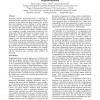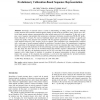150 search results - page 2 / 30 » A Geometric Representation of Protein Sequences |
CPM
2004
Springer
13 years 10 months ago
2004
Springer
In this paper we investigate the protein sequence design (PSD) problem (also known as the inverse protein folding problem) under the Canonical model 4 on 2D and 3D lattices [12, 25...
ISMB
1993
13 years 6 months ago
1993
Molecular sequence megaclassification is a technique for automated protein sequence analysis and annotation. Implementation of the method has been limited by the need to store and...
BIOCOMP
2008
13 years 6 months ago
2008
Protein structure comparison is important for elucidation of evolutionary relationships, function and functionally important amino acid residues. We propose Geometric Invariant bas...
ISVC
2007
Springer
13 years 11 months ago
2007
Springer
Abstract. The function of a protein is dependent on whether and how it can interact with various ligands. Therefore, an accurate prediction of protein-ligand interactions is paramo...
JCC
2008
13 years 5 months ago
2008
: Knowledge of structural classes is useful in understanding of folding patterns in proteins. Although existing structural class prediction methods applied virtually all state-of-t...


